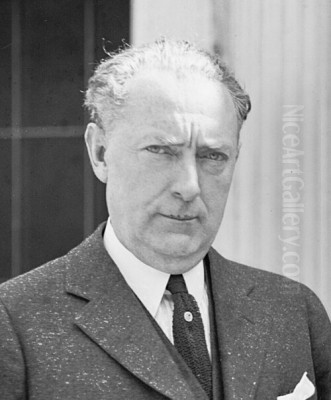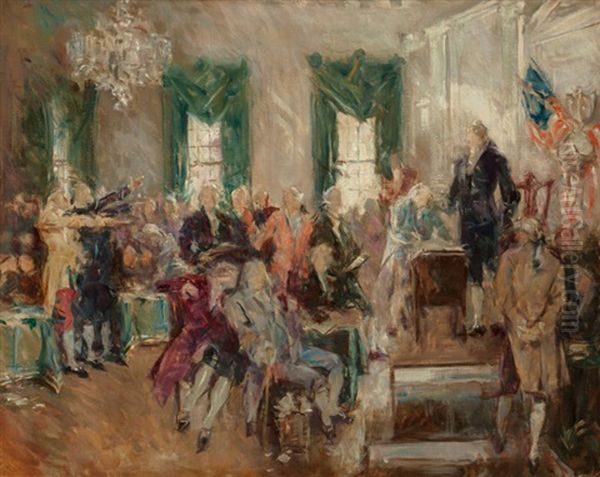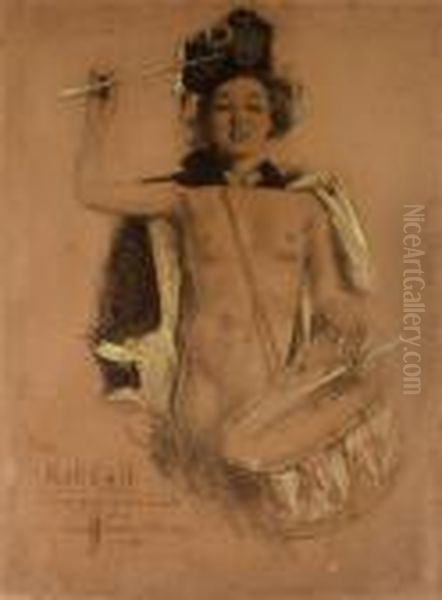
Howard Chandler Christy stands as a towering figure in the landscape of early 20th-century American art. Primarily celebrated as an illustrator, his name became synonymous with a particular vision of American idealism, patriotism, and feminine beauty. Yet, his prolific career extended beyond the pages of magazines and wartime posters to encompass society portraiture and monumental historical murals. Christy captured the zeitgeist of his era, creating images that not only reflected but also shaped American culture, leaving an indelible mark on the nation's visual identity. His journey from a farm in rural Ohio to the studios of New York City and the halls of the U.S. Capitol is a testament to his talent, ambition, and profound connection with the American public.
Early Life and Artistic Awakening
Howard Chandler Christy was born on January 10, 1873, on a farm in Morgan County, Ohio. Some accounts suggest an 1872 birth year, but 1873 is more widely accepted. His early years were spent near the small community of Duncan Falls, where the rural landscape likely nurtured his nascent artistic inclinations. From a young age, Christy demonstrated a passion for drawing, sketching the world around him.
His formal education was cut short. Around the age of twelve, due to his family's financial constraints, Christy left school to help on the family farm. However, this did not extinguish his artistic drive. He continued to draw and paint in his spare time, honing his skills through self-directed practice. This early period reveals a determination and dedication that would characterize his entire career.
Recognizing his potential, Christy eventually made his way to New York City, the epicenter of the American art world, to pursue formal training. This move was a significant step, taking him far from his rural roots and immersing him in a competitive and stimulating environment.
Training in New York: Forging an Artist

In New York, Christy sought instruction at prestigious institutions. He enrolled at the National Academy of Design, a cornerstone of American art education. He also studied at the Art Students League of New York, known for its progressive atmosphere and influential instructors. It was here, and possibly also through private instruction, that he came under the tutelage of William Merritt Chase.
Chase was one of the most respected American painters and teachers of his time, a leading figure associated with American Impressionism. Studying under Chase provided Christy with rigorous training in technique and composition, exposing him to contemporary artistic currents. While Christy would develop his own distinct style, the influence of Chase's emphasis on draftsmanship and vibrant brushwork can be discerned in his later work. Christy excelled in his studies, reportedly winning awards for his drawing skills upon completing his training. He even briefly taught at the Art Students League and the Cooper Union, indicating his early mastery of the craft.
The environment at institutions like the Art Students League would have put him in proximity to the ideas and works of other major figures, even if they weren't his direct instructors. Artists like Robert Henri were also teaching there around this period, fostering a dynamic atmosphere of artistic exploration that undoubtedly influenced the young Christy.
The Crucible of War: Rise to National Fame
Christy's breakthrough into the national spotlight came unexpectedly through conflict. In 1898, at the outbreak of the Spanish-American War, several major publications sent artists to the front lines to provide illustrations for the news-hungry public back home. Christy secured an assignment to travel to Cuba with the American troops, including Theodore Roosevelt's Rough Riders.
His illustrations, capturing the drama, heroism, and hardships of the war, were published in prominent magazines such as Scribner's Magazine, Harper's Weekly, and Leslie's Weekly. These vivid, on-the-spot depictions resonated deeply with Americans, offering a visual connection to the far-off conflict. His work stood alongside that of other noted illustrators covering the war, like Frederic Remington, although Christy's focus was often more on the human element and idealized figures.
This assignment catapulted Christy to fame. His name became widely recognized, and demand for his illustrations soared. The experience not only established his reputation but also seemed to instill in him a profound sense of patriotism that would become a recurring theme in his art.
The Birth of an Icon: The "Christy Girl"

Following his return from Cuba, Christy continued his work as a highly sought-after illustrator. One particular illustration published in Scribner's Magazine, titled "The Soldier's Dream," featured an idealized image of a young woman. This image struck a chord with the public and marked the genesis of what would become his most famous creation: the "Christy Girl."
The "Christy Girl" evolved into an archetype of American femininity in the early 20th century. She was typically depicted as vibrant, confident, elegant, and wholesome, often engaged in activities or embodying patriotic sentiments. She was athletic, intelligent, and alluring, representing a modern, active vision of womanhood. Her image graced the covers and pages of countless magazines, advertisements, and books.
She inevitably drew comparisons to the "Gibson Girl," created by Christy's contemporary, Charles Dana Gibson. While the Gibson Girl often embodied aristocratic elegance and a certain aloofness, the Christy Girl was generally perceived as more approachable, energetic, and overtly patriotic, particularly as the nation moved towards World War I. Both figures, however, played significant roles in defining ideals of beauty and behavior for American women of the era, disseminated widely through the power of mass media. Christy, alongside illustrators like Harrison Fisher and J.C. Leyendecker, helped define the visual culture of the "Golden Age of American Illustration."
Patriotism in Paint: World War I Propaganda
When the United States entered World War I in 1917, Howard Chandler Christy's established fame and his particular talent for creating appealing, patriotic imagery made him a natural choice for government service. He became one of the nation's leading artists contributing to the war effort through powerful propaganda posters.
Working for the Division of Pictorial Publicity, chaired by Charles Dana Gibson, Christy produced some of the most iconic images of the war. His posters were designed to stir patriotism, encourage enlistment, and promote the sale of Liberty Bonds. Famous examples include "Gee!! I Wish I Were a Man," depicting a stylish Christy Girl in a Navy uniform, wistfully looking on, implicitly challenging men to enlist. Another powerful image was "The Spirit of America," showing a determined, flag-draped female figure leading the charge.

His poster "Fight or Buy Bonds" combined the appeal of the Christy Girl with a direct call to action, urging citizens to support the war financially if they could not serve in combat. "Give Faith and Courage" was another notable work reinforcing national resolve. Christy masterfully employed symbolism – the American flag, military uniforms, allegorical figures – and combined it with his signature idealized style and vibrant colors to create emotionally resonant and persuasive messages. His work, alongside that of James Montgomery Flagg (creator of the famous "I Want You" poster), was instrumental in mobilizing public opinion and support for the war.
A Shift in Focus: Portraiture and Murals
While illustration brought Christy widespread fame and financial success, he harbored ambitions in the realm of traditional fine art, particularly portraiture and mural painting. Beginning in the 1920s, he increasingly turned his attention to these genres, leveraging his reputation to secure prestigious commissions.
He became a highly sought-after portrait painter, capturing the likenesses of prominent figures from politics, industry, and society. His subjects included several U.S. Presidents, such as Calvin Coolidge, Herbert Hoover, Franklin D. Roosevelt, and Harry S. Truman. He also painted military leaders like General Douglas MacArthur, aviation pioneer Amelia Earhart (often misidentified in summaries as Alice Earhart), humorist Will Rogers, WWI ace Eddie Rickenbacker, and even international figures like Italian dictator Benito Mussolini. His portrait style maintained the vibrancy and idealized quality of his illustrations but adapted to the formal requirements of the genre, sometimes echoing the society portraits of artists like John Singer Sargent, though with Christy's distinctively brighter palette.
His friendship with David Lynn, the Architect of the Capitol, proved instrumental in securing his most significant commission in this later phase of his career.
Crowning Achievement: The Capitol Mural
In the late 1930s, Christy embarked on his most ambitious project: a monumental mural for the U.S. Capitol Building in Washington, D.C. Commissioned by Congress, the painting, titled "Scene at the Signing of the Constitution of the United States," was destined for the east grand stairway of the House of Representatives wing.
This massive undertaking, measuring 20 by 30 feet, occupied Christy for several years. He conducted extensive historical research to accurately depict the delegates and the setting of the Constitutional Convention in Philadelphia in 1787. The mural features portraits of nearly all the signatories, arranged in a dynamic composition that conveys the gravity and importance of the historical moment.
Completed and installed in 1940, the mural was a significant artistic and logistical achievement. It was reported to be one of the most expensive government art commissions of its time. The work placed Christy firmly within the tradition of American history painting and muralists like Edwin Austin Abbey and John La Farge, who had adorned public buildings with grand historical narratives earlier. The Capitol mural remains one of Christy's most enduring public works, viewed by countless visitors to the seat of American government.
Artistic Style and Techniques Revisited
Throughout his diverse career, certain stylistic hallmarks remained consistent in Howard Chandler Christy's work. His art is characterized by a strong sense of idealized realism. Figures, particularly women, are depicted with smooth features, vibrant health, and an air of confidence and vitality. His use of color was bold and often high-key, contributing to the optimistic and energetic mood of many of his pieces.
Compositionally, Christy demonstrated a strong sense of design, often employing clear focal points and balanced arrangements. In his posters, he skillfully used visual rhetoric, employing symbols like the flag or allegorical figures to convey messages directly and effectively. His WWI posters often featured dynamic diagonals or stable, iconic symmetry to enhance their impact.
While best known for his oil paintings and illustrations (often reproduced from paintings or drawings), Christy was also adept with other media, including pastel and watercolor. His draftsmanship was consistently strong, providing a solid foundation for his idealized figures and detailed settings. Whether creating an intimate illustration, a formal portrait, or a grand historical mural, Christy's style remained accessible, engaging, and fundamentally optimistic, reflecting the aspirational spirit of America during his time. His work often stood in contrast to the grittier realism being explored by contemporaries associated with the Ashcan School, such as Robert Henri or John Sloan, or the more decorative styles of artists like Maxfield Parrish.
Personal Life and Later Years
Howard Chandler Christy's personal life was intertwined with his art. He was married twice. His first marriage was to Mabelle Gertrude Thompson. His second marriage, in 1919, was to Nancy Palmer, a model who had frequently posed for him. Nancy became one of the primary inspirations and models for the quintessential "Christy Girl," embodying the vibrant spirit he sought to capture. Their collaboration highlights the close relationship between artist and model that often fueled the creation of these iconic images.
For many years, Christy maintained a prominent studio in the Hotel des Artistes, a famous building near Central Park West in New York City known for its grand, double-height studio spaces favored by artists. This placed him at the heart of the city's artistic community.
He remained an active artist well into his later years, continuing to paint portraits and other works. Howard Chandler Christy passed away in his New York studio on March 3, 1952, at the age of 79, leaving behind a vast body of work that had significantly shaped American visual culture.
Legacy and Critical Reception
Howard Chandler Christy's legacy is multifaceted. He achieved immense popularity and commercial success during his lifetime, arguably becoming one of the most recognized artists in America. The "Christy Girl" remains an enduring symbol of early 20th-century American femininity and patriotism, studied today for its cultural significance and role in shaping gender ideals. His World War I posters are considered masterpieces of propaganda art, demonstrating the power of visual imagery in mobilizing a nation.
Critically, Christy's position has been complex. During his lifetime, the distinction between "high art" (painting, sculpture) and "low art" (illustration) was often sharply drawn. While immensely popular with the public, his work, particularly his illustrations, was sometimes viewed by art critics as overly commercial or lacking the depth of fine art painting. His idealized style, while appealing, has also drawn criticism for potentially reinforcing stereotypes or presenting a sanitized view of reality.
However, contemporary assessments often take a broader view, recognizing the artistic skill, cultural impact, and historical significance of his work across all genres. He is acknowledged as a master illustrator who profoundly influenced American popular culture, fashion, and national identity. His portraits captured the likenesses of key figures of his time, and his Capitol mural stands as a major contribution to American history painting. Alongside contemporaries like Gibson, Flagg, Leyendecker, and under the influence of teachers like Chase, Christy carved out a unique and influential place in American art history. His ability to connect with the public and create resonant images cemented his status as a defining visual chronicler of his era.
Conclusion
Howard Chandler Christy was more than just an artist; he was an image-maker who helped define the visual narrative of America in the first half of the 20th century. From the battlefields of Cuba to the pages of popular magazines, from the patriotic fervor of wartime posters to the hallowed halls of the U.S. Capitol, his art captured and conveyed the ideals, aspirations, and spirit of his time. The "Christy Girl" became an icon, his posters rallied a nation, and his portraits and murals recorded history. Though critical opinions may vary, his technical skill, his immense popularity, and his undeniable impact on American culture secure Howard Chandler Christy's place as a significant and enduring figure in American art history. His work continues to offer a vibrant window into the nation's past.